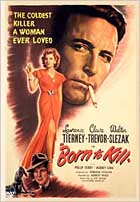
BUY IT
AT AMAZON: CLICK HERE!
STUDIO: RKO Radio Pictures, Inc.
MSRP: $13.98
RATED: Unrated
RUNNING TIME: 83 Mins.
SPECIAL FEATURES: Commentary by Author/Historian Eddie Muller with audio excerpts of Director
Robert Wise
This
DVD is part of The Warner Brothers Film Noir Boxed Set: Volume 02 (Buy it
from CHUD and save your dollar bills!).
One of the great things about the Postwar period in America was that the dark underbelly of American life began to materialize (the talkback would follow a half century later), bringing with it a wealth of new motives from the seediest people imaginable. Their emotional responses thrived upon a harsh depiction of greed, double-dealings, unbridled lust, and above all, an ambivalent cruelty that permeated every shadowy move, pelvic thrust, and gun shot out into the cold dark night. Those who were able to dodge bullets (or know kung fu and wire work) were changed for the worse, as these melodramatic crime films cut a deep swath across the face of America’s newest gleeful interest in immoral crookedness.
Robert Wise cut his teeth as an editor before making the jump into film directing (then upgrading to the new directordentures5000), ultimately paying his dues crafting some fine pictures (like The Set-Up, included in WB’s first Film Noir boxed set, which you can purchase here) before segueing into the later musical spectacles (Sound Of Music, West Side Story) that would bring him unanimous acclaim (and younger viewers to change the channel, citing boring non-MTV editing). One of those films that he explored America’s new interest with was that of the Laurence Tierney film Born To Kill. Characterized as one of the de facto film noirs, Born To Kill contains those many instances of corrupt characters damming themselves straight to the depths of hell.
The Flick

"I’m gonna haunt you in your dreams, kiddies!"
Noir Queen Claire Trevor is Helen Brent, a woman who knows what life has in store for people like her, especially after her seemingly horrendous divorce. She’s regulated herself to living in a boarding house lorded over by the beer swilling loud mouthed drunkard Mrs. Kraft (played by Esther Howard), but the time has come to plan her escape back home to the good graces of her much wealthier sister, Georgia Staples. Next door to her lives a floozy named Laury Palmer, who ushered my thoughts into wondering if Lynch had borrowed her name (and bits of her psyche) for the Twin Peaks series (what a freaky movie … especially Bob). Anyway, Laury is the type of woman who doesn’t like the letters i and e and keeps two boyfriends on the side, one whom she loves enough to possibly marry, and the other for some fun, played by Laurence Tierney. The side effect is that there’s bound to be some jealousy. What happens, though, isn’t what anyone bargained for.
Tierney is the menacing Sam Wild, whose name should conjure up the necessary unsubtle imagery associated with a (seemingly psychotic) man who spouts off exchanges like: "I never let anybody cut in on me, ever" before confidently stating the he sees what he wants and takes it immediately. Sam is one of those great gigantic assholes of a character, a man so assured that he’s going to come out on top, that he’ll just bully his way around until he’s more comfortable with the situation. This is the guy who stole your lunch money and T2 trading cards on the playground. Sam has one hell of a vicious temper, so it’s only par for the course for him to be a little more than jealous when he finds Laury with her boyfriend she conveniently forgot to tell him about. Snapping faster than the safety cap on a bottle of pills for anyone associated with counting the gross on Pluto Nash, Sam quickly and efficiently kills both Laury and her boyfriend under the coldest of circumstances. Oddly enough, I believe the same thing occurred with that above-mentioned travesty.
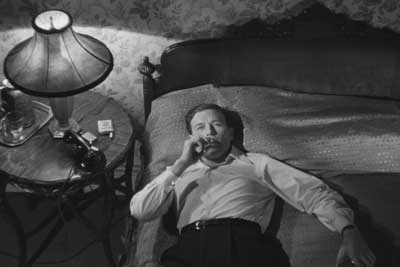
"Maybe if I keep smokin’ this stuff, I can finally see those Suvari aliens…"
Showing no remorse, he confesses his minor infidelity to roommate Marty Waterman (typecast noir dude Elisha Cook Jr. – you’ll see him pop up again!) and the pair conspire a simple plan to get Sam to San Francisco while the action in their hometown heats up enough to put the Police out in full force. Back at the house, Helen accidentally stumbles into Laury’s home and discovers the grisly pair strewn across the floor. Rather than tell anyone, she slowly slinks out and keeps her mouth shut. At this point, it’s interesting to understand why Helen would do such a thing, and later on, she’ll shrug this off in a nonchalant way, copping to not wanting to bother anyone about it. Helen is one cold-hearted snake (look into her eyes) who only cares about herself. All is for naught, though, as she leaves in a flourish of cold emotions and left over pizza to the train station. It’s there where Sam and Helen meet, and Sam likes what he sees. Much to the chagrin of good guys everywhere (who lament their emo misfortunes on internet Message Boards), Sam does the only thing he can to get Helen to reciprocate; he treats her like a huge cock. On the train there’s some oddly subtle sexual tension, as both of the characters verbally feel each other out, you can’t but help to start to feel the heat bursting from underneath their steely veneers. A heat so intense, a steaming filthy rainbow of sexiness might protrude out of the cabin, causing erotic blindness. Much like your daily viewings of CSPAN.
It’s when private investigator Albert Arnett (played by Walter Slezak, who is more Zack than Sleestack) gets involved under Mrs. Kraft’s money that things start to get complicated. Sam unexpectedly visits Helen’s sister’s estate, and the sparks continue to fly, even though she’s engaged to be married. That doesn’t stop his plans to mercilessly chip away at her life, trying again and again to conquer her ideals he sees that he can have fun with. It’s only when Sam detours, marrying her wealthy foster sister Georgia (played by Audrey Long, who married the master filmmaker Billy Wilder) that the back-alley love between Sam and Helen reaches a white-hot intensity. Helen can’t help but be turned off intensely by Sam’s evil ways, yet drawn to his inexplicable allure that floats around, stinging all women in his path. Sadly enough, Robert Z’Dar knows all about this blessing and curse.
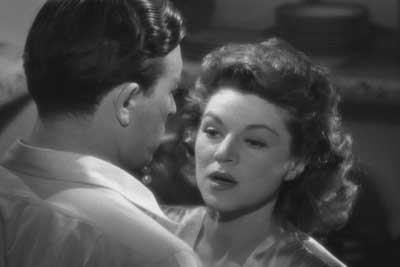
"Theatrics! I. Just. Can’t. Stop!"
As Arnett’s Bible quoting dick sneakily and suspiciously trails Sam’s horrific past, Helen and Sam consummate their feelings over one another in a seriously sick conversation involving Helen’s discovery of the bodies and why Sam is turned on tremendously for her abilities to not speak up and turn him in. It’s the moments like this where the seedy melodramatic qualities of Born To Kill are really in full force, as they sting your enjoyment of the film with barbs of their skewed lust. The consequences of this fateful encounter only mean one thing, that Helen now understands Sam’s motives and vicious desires, but also knows what he’s capable of unleashing on people if the situation should turn sour (like if you were Goin’ South with Nicholson). Once the film reaches this dramatic point, there’s no turning back, and each character must fully embrace of deny their dates with destiny or perish in a noir hell filled with gun shots, knife stabs, sandy dunes and hardened wood (not in the pants).
As a melodrama, Born To Kill is demented beyond belief. It’s quite possible that most of the credit belongs to well-known bad boy Laurence Tierney (who younger audience members will probably remember from Reservoir Dogs), but it does spill over into other characters motives, greediness, and double-dealings against one another. His corruptible ways influence everything against the inherent goodness America prides itself on. The exaggerated emotional response of people like Sam creates a slimy bad guy you love to hate, and by all means, Tierney plays it with such intense relish that you can’t help but fall into his spell of animalistic behavior (hell, he even exhales smoke out of his nose like a horse in heat would). Claire Trevor’s interpersonal conflict with herself against the relentless advances of Sam showcases why she’s such a stereotypical noir Queen, however, she’s one of the better portrayals of unbridled lust featured in these types of movies. Her Helen is filled with a weariness of the world, a snarky quality that doesn’t trust anyone or anything, so it’s only the natural course of events that she fall in love with the most ruthless character in the picture, one who would kill her even though he might one day come to love her busty bosom. These are two wonderfully doomed from the start portrayals from two actors that understand and throw themselves into these characters.
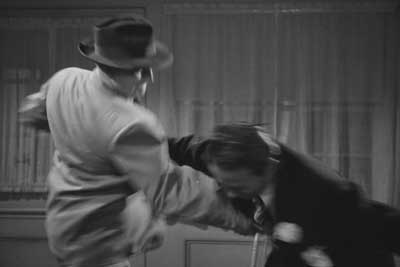
Ha-do-ken!
This is an A-picture all the way, as Robert Wise elevates the film with such economy (something he’d learned before doing his time in B-land) and emotional visceral qualities that keep it interesting and a float. One of the primary instances that sticks out for me is the scene in which Helen discovers the bodies of Laury and her boyfriend. Rather than just shock you with bodies that are there, Wise chooses specific body parts, and shrouds them in a dark mystery of light coupled with as little sound as possible. The effect is much more powerful than you’d imagine and helps drive home the horrific nature of what unfolded behind the door. Additionally, as previously mentioned, Wise’s grip on the material helps inform him of the gleefully demented qualities exhibited by Helen and Sam’s conversation around the discovery. He does a good job conveying the necessary elements, and he aids in telling a good story.
The music, provided by workman composer Paul Sawtell (he’d also score Faster Pussycat, Kill! Kill! before he kicked the death bucket) doesn’t help the picture much with its misunderstanding of serious emotional elements. It’s melodramatic in intent, and I believe it works out in the end. One of the things you’ve got to realize about music in older films is that it’s meant to be manipulative. In conjunction with the imagery at hand, music is one of the last driving forces of pushing you towards a specific emotional response, and Sawtell’s aural concoctions do just that. No one ever questioned these back in the day, but demanding that these instances be less subtle is almost demeaning.

"That’s the last time I fall for Uncle Mitch and his party girl antics!"
In the end, Born To Kill is a very good noir film. It’s not one of the very best (like say, The Big Sleep or Double Indemnity), but it is a nasty noir cookie full of dementia anchored by the great coupling of Laurence Tierney and Claire Trevor.
7.8 out of 10
The Look
Presented in the films original 1.33:1 aspect ratio. Image wise, the film has some great sequences courtesy of cinematographer Robert De Grasse’s expressive use of blacks, grays, and shadowy instances of mixed visceral depth. De Grasse had worked with Wise before (on The Body Snatcher) and it appears as if it was a fruitful then as it was for Born To Kill. DVD-wise, there is a minor amount of relative wear and tear on the print used for digitizing, especially in the sand dunes sequence, but as a whole, its contrast is splendid and cacophony of blacks enhance the right amount of depth.
8.0 out of 10
The Noise
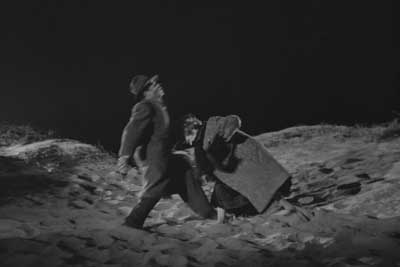
Escaping Certain Doom: Lesson No. 12: Always use the headbutt.
Dolby Digital 1.0 Mono. It’s crystal clear, allowing you to be further enthralled (or repulsed) by the lines of dialogue that are as sharp and evil as they are enjoyable. No complaints here, and if Warner did some extensive reshaping and retooling of the original audio track(s) involved with their new Dolby mix, all I can’t say is that I can’t tell. That’s a great compliment to my relatively gullible ears.
8.0 out of 10
The Goodies
All you get is a commentary with Eddie Muller, author of The Art of Noir (purchase it from CHUD here!) and Dark City: The Lost Art of Film Noir (buy that from CHUD here!) with additional audio excerpts from director Robert Wise. Now, Muller is as informative as it gets. I had the interesting experience of meeting him in person when they had a noir retrospective at the Egyptian theater in L.A. and he’s a very knowledgeable person. Such is also the case on the DVD, where he waxed poetically about noir as a whole, screenplays, shooting styles (relationships within Born To Kill), suspicions among words, inaccuracies within the movie itself, and a rather telling tale of a Q&A screening at the Egyptian involving Wise and Tierney going head to head, the end result being that Tierney tells Wise that it was all in "the motherfucking script" before heading to the bathroom to call all of the gawking people around him "cocksuckers". I kid you not. Wise, on the other hand, pops up every once and a while and due to his age (90), his voice is mostly warbled and extremely low. I had to turn up the sound a lot just to make out what he had to say (which is ultimately informative). This is a pretty good track and worth your time should you choose.
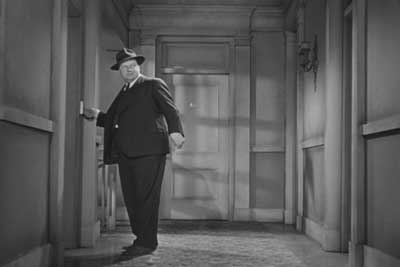
"Hope you cocksuckers enjoyed my humongous fart!"
Granted there’s no trailer, no featurette, or even another trailer for something else WB noir related. That’s a shame.
5.0 out of 10
The Artwork
Classic noir style. Tierney, smoking in badass pose, strikes it up against the vamp-y Claire Trevor and her revealing dress, showing the right amount of sexuality for the late 40’s. Trevor’s stepping mighty heavy on Walter Slezak though, and his look of happiness is okay, partly because I think he might be having some trouble with the ladies. Anything to help him out, right? Other than that, the tagline comes across loud and clear. Fitting.
8.0 out of 10